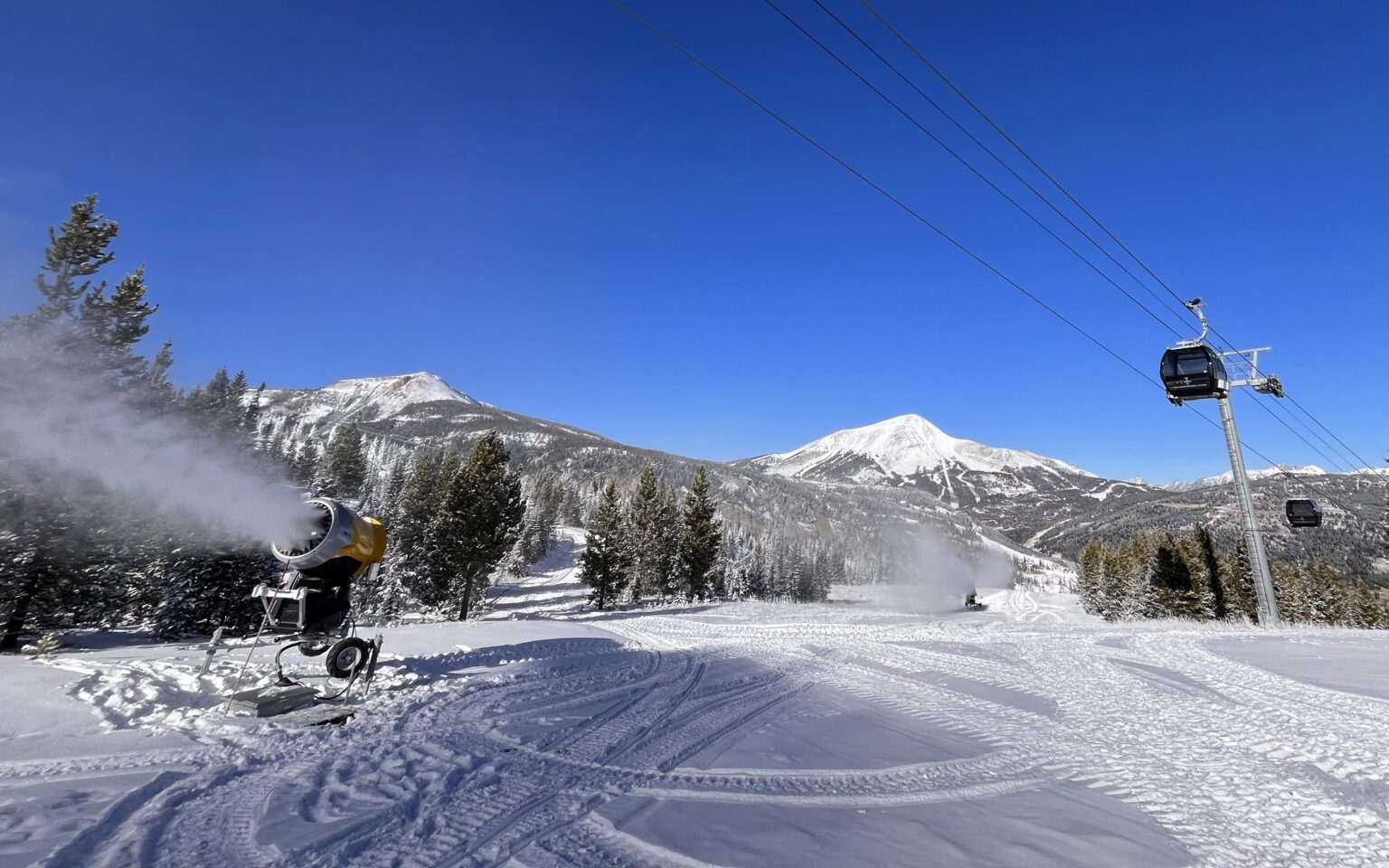Water is a limited resource. More and more headlines report threats to water supplies, both here in Montana and across the West. Our community water resources are stretched to capacity, and regional and local water systems face impacts from drought and population growth. With forecasts showing cumulatively warmer and drier seasons ahead, innovative solutions are needed to support strained water systems. A community like Big Sky—where water is critical to our seasonal economic activity—is inclined to find sustainable solutions.
One such solution is currently making its debut at Big Sky’s Yellowstone Club, where the inaugural season of snowmaking from reclaimed water is finally a go after nearly two decades of planning and pilot projects. The first of its kind in Montana, it is the result of years spent exploring the opportunity, managing samples, adapting to state regulations, monitoring, and careful permitting from state agencies to get this win-win-win project up and running.
A resilient water supply depends on a combination of water conservation and strategic water reuse. The latter is what has led to the Yellowstone Club being one of only a few areas in the country taking on reclaimed water reuse in snowmaking as both a solution to limited water sources, and a proactive means to safeguard a watershed from increased nutrient loading in groundwater and earlier, lower seasonal runoff.
Strategic water reuse is increasingly becoming a leading solution for drought resilience and changing snowfall patterns. In Big Sky, especially in a season like we’re in now, reuse also benefits ski areas by allowing for more acreage to be opened at the start of a low-snow year. But the path to using reclaimed water for snowmaking as a solution to drought and a healthier watershed didn’t happen overnight.
The reclaimed water snowmaking project was first explored in 1997 by the Big Sky County Water and Sewer District as a way to explore options for reusing water in the winter months. After promising results from a pilot project in 2011 that indicated no detriments to water quality, the option was prioritized in the 2018 Big Sky Sustainable Watershed Stewardship Plan produced by the Gallatin River Task Force.
Concerns about Big Sky’s water supply, and the interest in how to use Big Sky’s highly treated reclaimed water, led the work to solve the water challenge: find a way to use reclaimed water that would bolster the upper Gallatin’s water supply, reduce nutrient pollution and support a more resilient snowpack. Big Sky’s new $50 million Wastewater Resource Recovery Facility will treat wastewater to an even higher standard of quality, adding to the potential uses for reclaimed water to bolster our watershed.
“The project ticks a lot of positive boxes”, said Trout Unlimited’s Montana Water Director, Pat Byorth, who participated in the development of the plan. “Using treated reclaimed water to make snow improves the ability to remove additional nutrients, store water as snowpack, and boost streamflows in spring and early summer. Happier skiers, anglers, boaters and downstream irrigators are a bonus to a project that has the Gallatin’s health as a priority.”
From the 2011 pilot study onward, changes were made by the state legislature, state agencies and Environmental Protection Agency to allow for snowmaking as an adopted tool for reuse. The Yellowstone Club ultimately obtained permits and approvals from the Montana Department of Natural Resources and Conservation and the Montana Department of Environmental Quality to allow snowmaking with reclaimed water.
The permit stipulated that the Club must continually monitor the project to discern if, and how, melting snow is impacting the health of surrounding tributaries. Leading up to its decision, and as part of the permitting process, the DEQ completed an environmental assessment of the snowmaking project, which confirmed that impacts to water quality, wildlife and plant life, among other resources considered, would be insignificant.
The project was met with an abundance of support both from individuals and businesses in Big Sky, and from environmental groups and regional partners in river health and water conservation.
“This program is only possible because of the determination of so many in Big Sky and the broader southwest Montana region to find a sustainable solution for our water”, said Rich Chandler, director of environmental operations at the Yellowstone Club. “From start to finish, the project was driven by collective, steadfast work—the community, government entities, businesses and local agencies. It truly speaks to the power of collaboration, and has already turned out inquiries from other Montana ski mountains with an interest in replicating the program.”
The snowmaking project at play at YC could equate to a 25-million-gallon net benefit to our community watershed, with the added volume extending our spring season of cold water flow into the Gallatin by as many as 19 days. These benefits make it even more appealing to look down the road at the opportunity this opens for Spanish Peaks Mountain Club and Big Sky Resort.
Big Sky is at a crossroads with limited water resources in the upper Gallatin watershed and climate impacts hurting traditional water supplies including snowpack. The good news is that with this newly launched reclaimed water snowmaking project, we are moving in the right direction, with the right tools steeped in environmental focus, allowing us to take the lead on how we protect our community water and treasured resources like the Gallatin River for the future.
Marne Hayes is the communications manager for the Gallatin River Task Force.

